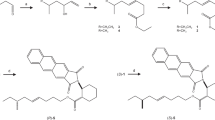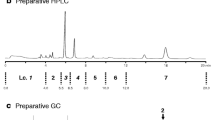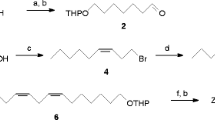Abstract
Derivatives of 2,2-dimethyl-3-(2-methylprop-1-enyl)cyclopropanecarboxylic acid (chrysanthemic acid) are classic natural pyrethroids discovered in pyrethrum plants and show insecticidal activity. Chrysanthemic acid, with two asymmetric carbons, has four possible stereoisomers, and most natural pyrethroids have the (1R,3R)-trans configuration. Interestingly, chrysanthemic acid–related structures are also found in insect sex pheromones; carboxylic esters of (1R,3R)-trans-(2,2-dimethyl-3-(2-methylprop-1-enyl)cyclopropyl)methanol (chrysanthemyl alcohol) have been reported from two mealybug species. In the present study, another ester of chrysanthemyl alcohol was discovered from the striped mealybug, Ferrisia virgata (Cockerell), as its pheromone. By means of gas chromatography–mass spectrometry, nuclear magnetic resonance spectrometry, and high-performance liquid chromatography analyses using a chiral stationary phase column and authentic standards, the pheromone was identified as (1S,3R)-(−)-cis-chrysanthemyl tiglate. The (1S,3R)-enantiomer strongly attracted adult males in a greenhouse trapping bioassay, whereas the other enantiomers showed only weak activity. The cis configuration of the chrysanthemic acid–related structure appears to be relatively scarce in nature, and this is the first example reported from arthropods.



Similar content being viewed by others
References
Ben-Dov Y (1994) A systematic catalogue of the mealybugs of the world. Intercept, Andover, p 686
Charles JG (2005) Mealybug insecticide resistance management strategy. In: Martin NA, Beresford RM, Harrington KC (eds) Pesticide resistance: prevention and management strategies. New Zealand Plant Protection Society, Hastings, pp 126–132
El-Sayed AM, Unelius CR, Twidle A, Mitchell V, Manning L-A, Cole L, Suckling DM, Flores MF, Zaviezo T, Bergmann J (2010) Chrysanthemyl 2-acetoxy-3-methylbutanoate: the sex pheromone of the citrophilous mealybug, Pseudococcus calceolariae. Tetrahedron Lett 51:1075–1078
Ghose SK, Paul PK (1972) Observation on the biology of the mealybug, Ferrisia virgata (Cockerell) (Pseudococcidae: Hemiptera). Proc Zool Soc (Calcutta) 25:39–48
Gullan PJ, Downie DA, Steffan SA (2003) A new pest species of the mealybug genus Ferrisia Fullaway (Hemiptera: Pseudococcidae) from the United States. Ann Entomol Soc Am 96:723–737
Gut LJ, Stelinski LL, Thomson DR, Miller JR (2004) Behaviour-modifying chemicals: prospects and constraints in IPM. In: Koul O, Dhaliwal GS, Cuperus GW (eds) Integrated pest management: potential, constraints and challenges. CABI Publishing, Oxford, pp 73–122
Hesse M, Meizer H, Zeeh B (2008) Spectroscopic methods in organic chemistry. Georg Thieme Verlag KG, Stuttgart, pp 74–241
Ho H-Y, Su Y-T, Ko C-H, Tsai M-Y (2009) Identification and synthesis of the sex pheromone of the Madeira mealybug, Phenacoccus madeirensis green. J Chem Ecol 35:724–732
Hughes WA, Lister CA (1953) Lime die-back in the gold coast, a virus disease of the lime, Citrus aurantifolia (Christmann) Swingle. J Hort Sci 28:131–140
Jara V, Meza FJ, Zaviezo T, Chorbadjian R (2013) Climate change impacts on invasive potential of pink hibiscus mealybug, Maconellicoccus hirsutus (green), in Chile. Clim Chang 117:305–317
Kaydan MB, Gullan PJ (2012) A taxonomic revision of the mealybug genus Ferrisia Fullaway (Hemiptera: Pseudococcidae), with descriptions of eight new species and a new genus. Zootaxa 3543:1–65
Khambay BPS, Jewess PJ (2010) Pyrethroids. In: Gilbert LI, Gill SS (eds) Insect control. Academic Press, London, pp 1–29
Kim B-H, Lee SU, Kim KT, Lee J-Y, Choi NH, Han Y-K, Ok JH (2003) Enantiomeric discrimination of pyrethroic acid esters on polysaccharide derived chiral stationary phases. Chirality 15:276–283
Le Pellery RH (1968) Pest of coffee. Longmans, London, p 590
Morishita M (2005) Resurgence of Japanese mealybug, Planococcus kraunhiae (Kuwana), in persimmon induced by a synthetic pyrethroid cypermethrin. Annu Rep Kansai Plant Protect Soc 47:125–126
Posnette AF, Strickland AH (1948) Virus diseases of cacao in west Africa. Ann Appl Biol 35:53–63
Sawamura N, Narai Y, Teshiba M, Tsutsumi T, Mochizuki M, Toda S, Suzuki T, Ichihashi H, Tabata J, Sasaki R (2015) Forecasting the occurrence of young Japanese mealybug larva Planococcus kraunhiae (Kuwana) (Hemiptera: Pseudococcidae) using sex pheromone traps and total effective temperature for persimmon. Jpn J Appl Entomol 59:183–189
Tabata J, Ichiki RT (2015) A new lavandulol-related monoterpene in the sex pheromone of the grey pineapple mealybug, Dysmicoccus neobrevipes. J Chem Ecol 41:194–201
Tabata J, Ichiki RT (2016) Sex pheromone of the cotton mealybug, Phenacoccus solenopsis, with an unusual cyclobutane structure. J Chem Ecol 42:1193–1200
Tabata J, Ichiki RT, Moromizato C, Mori K (2017) Sex pheromone of a coccoid insect with sexual and asexual lineages: fate of an ancestrally essential sexual signal in parthenogenetic females. J R Soc Interface 14:20170027
Unelius CR, El-Sayed AM, Twidle A, Bunn B, Zaviezo T, Flores MF, Bell V, Bergmann J (2011) The absolute configuration of the sex pheromone of the citrophilous mealybug, Pseudococcus calceolariae. J Chem Ecol 37:166–172
Wesołowska A, Grzeszczuk M, Kulpa D (2015) GC-MS analysis of the essential oil from flowers of Chrysanthemum coronarium L. propagated conventionally and derived from in vitro cultures. Acta Chromatogr 27:525–539
Zou Y, Millar JG (2015) Chemistry of the pheromones of scale and mealybug insects. Nat Prod Rep 32:1067–1113
Acknowledgments
NMR spectrometry analyses were carried out with the support of the Advanced Analysis Center at the National Agriculture and Food Research Organization. We acknowledge a grant-in-aid for scientific research from the Japan Society for the Promotion of Science (no. 16 K08103) to JT.
Author information
Authors and Affiliations
Corresponding author
Rights and permissions
About this article
Cite this article
Tabata, J., Ichiki, R.T. (1S,3R)-cis-Chrysanthemyl Tiglate: Sex Pheromone of the Striped Mealybug, Ferrisia virgata . J Chem Ecol 43, 745–752 (2017). https://doi.org/10.1007/s10886-017-0879-z
Received:
Revised:
Accepted:
Published:
Issue Date:
DOI: https://doi.org/10.1007/s10886-017-0879-z




